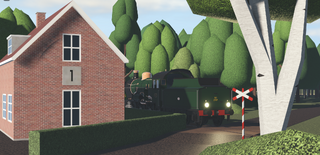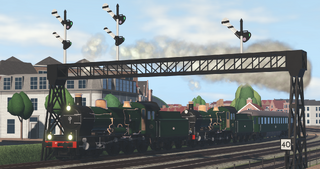| NS 3700 | |
|---|---|
| by Jiskpirate | |
| Price | ƒ200.000 |
| Level | 52 |
| Statistics | |
| Type | Passenger |
| Top Speed | 110 km/h |
| Weight | 115 tons |
| Capacity | 410 tons |
| Passenger Capacity | 3 first class 3 second class |
| Length | 18,6 meters |
The NS 3700 was a series of 120 2'C (4-6-0) express steam locomotives that were used for nearly half a century, lasting to the very end of steam traction. They formed the basis for a variety of other classes.
Variants
The NS 3700 is available in three liveries, all in Nederlandsche Spoorwegen green; Standard, Austerity & Exhaust injector. It also received a snow plow during the 2024 winter season based on the standard variant.
Historical Details
The beginnings
The NS 3700 were originally ordered by the Staatsspoorwegen (SS) as the SS 701-705 series. They were ordered at Beyer, Peacock & Co. (and later 4 other companies) after some successful trials with 2'C locomotives from the NBDS (later the NS 3500), as the SS had no experience with this wheel arrangement. The first group entered service in 1910 and performed so well that more of these were ordered up until 1921 without any significant changes in the design, with NS ordering 5 somewhat different locomotives in 1928. Their size and tremendous power, twice that of the strongest 2'B (4-4-0) locomotives of the SS (later the NS 1700), they got the nickname "Jumbo".
The design worked so well, in fact, that two attempts (NS 6000 & NS 6100) were made to create a tank locomotive version by the SS and NS respectively. They also were used for the only Dutch attempt at streamlining steam locomotives (see Potvis) and formed the basis of the NS 3900.
Post-fusion
In the years prior to WWII, the 3700s were among the most important locomotives NS owned and pulled trains across the entirety of the Netherlands, only losing a little ground when their big brothers, the NS 3900, entered service in the 1930s. However, in those same years they showed their worth when the new diesel-electric multiple units broke down, it was up to the 3700s to drive the replacement trains according to the very tightly scheduled diesel time table. These replacement services, dubbed 'Steamdiesels' by the public, were given only to the most capable drivers and got to use the best, carefully reserved fuel.
The end of the road

During WWII, 3721-3732 were placed along various border depots, from which they ventured into Germany. The 3794-3798 were lent to the German railways for ƒ 25,- a day between early 1942 and 1944, during which they exclusively drove with German personnel on German track. Some of these locomotives were among the 13 locomotives that disappeared to the other side of the iron curtain, though 53 others that were missing after the war were retrieved. Of these, the 3709/39/70/82/83/90 and the 3814 were irreparable and were scrapped in 1947.
After the war, the 3700s were mostly stationed at nine large depots, doing various jobs until being demoted to mainly goods work. The 3756 was the eighth locomotive of the series to be scrapped, after a frontal collision with NS 4525 in 1951. The remaining 99 of the class remained in service until the final withdrawal of steam between 1953-1957.
NS 3737 "The old lady"
NS 3737, a back-up locomotive at Roosendaal depot, would be the last of her kind and the last NS steam locomotive in service. She had been reserved for the railway museum since 1956 and had been given a special sign telling crew not to remove parts. In the same year she got her copper crown back, something locomotives lost in the war. The tender of NS 3746 had been preserved, to be placed behind 3737. With those, she pulled a special goodbye ride on the 7th of January, 1958, to the railway museum in Utrecht. With the end of the trip came an end of her service life and the end of steam traction of the Nederlandsche Spoorwegen. She was brought to Roosendaal to be conserved and given to the railway museum in September of that year.
However, in 1972, the 3737 was brought to the NS workshop in Tilburg, where she was brought back to operational conditions. Since then, she pulled various special trains at heritage lines and the mainline. In 1996, she got a new boiler and firebox with the intention of using her more regularly, but lower maintenance standards over the years took their toll and the 3737 broke down after only a few runs. She has been a static display object since 2002, with no plans to change this as modern safety standards would require the museum to alter the currently historic cab interior.
Technical details
The 3700s were equipped with a Westinghouse brake (both automatic and manual); a Knorr-preheater; a Hasler speedometer; a Webb firebox door and both Ashton- and (double) Ramsbottom security, under the same lining of the firebox.
SS 767-778 (build by Werkspoor, later NS 3773-3774) had a different kind of superheater and subsequently a larger firebox door. The Knorr-preheaters were installed from 1918 onwards. The locomotives 3729/39/44/59/62/64/66/87/88/95/96, 3800-3806, 3810 and 3815 received a Davies & Metcalfe exhaust-injector between 1924-1944, during the installation of which, the Knorr-preheater was removed. On some locomotives, the sometimes malfunctioning Wakefield-greasers were replaced with Friedmann-greasers.
Originally the driver stood on the left side of the cab, as was usual for SS locomotives. Locomotives that were put into service from 1918 were delivered with the driver's spot on the right side and in September of that year, a start was made on moving it from the left to the right on the older locomotives.
The 3785-3790 (build by Werkspoor) were build with tenders in 'shipshape', after the design of the then director of Werkspoor. In 1923, the 3701-3720 received the new four-axle 'ship tenders' so they could be used more efficiently on long services.
In 1932, a new cylinder block was designed for 3819 which was placed on a large number of the other 3700s. A locomotive that had received the new cylinder block was recognisable by the elevated platform on which the firebox rested. The replacement of the blocks went on until 1951; 3738 was the last to receive them. 26 of the 120 locomotives, including 3737, never got the new cylinder blocks.
Because the maximum allowed speed for passenger trains was steadily increased from 90 km/h to 110 km/h, the 3700s received brakes on their bogies starting in 1932. However, not all locomotives had this. During the war, the maximum speed was lowered back to 90 km/h, so the bogie brakes were deemed 'less necessary'. Partially to preserve the tyres on the wheels, the brakes were 'put out of service' by having their airpipes blocked off.
In 1946, 1947 and respectively 1948, the 3712, 3748 and 3732 got boilers with steel fireboxes. The boilers of 3712 and 3748 were scrapped in 1950 and 1952. 3732's boiler got a copper firebox, again, in 1953. That same firebox was later used by 3780.
After 1949, the 3700s got a lot of parts from the Austerity locomotives that were put out of service. Not every locomotive did, which created a large set of diversity. Among the parts the 3700 received are firebox doors and their respective foundation rings, air pumps, Gresham & Craven-Monitor-injectors and tenders. 62 Austerity tenders have served behind a 3700. These tenders, modified to function behind a 3700, were numbered 4801-4862.
Trivia
- Despite in-game being more powerful, the NS 4000 has more tractive effort than the NS 3700 in real life.
- The NS 3700 is to be viewed as a late game passenger locomotive, with the highest 1st class capacity, second highest 2nd class capacity and a respectable total capacity of 410 tons. It retains a high top speed of 110kph, and favourable length for an express engine.
- The in-game model currently features a flat sided 3 axle tender. The NS 3700 saw numerous designs of tender throughout their working life, including the British austerity tender as seen on the NS 4300/5000.
- The NS 3700 has featured on multiple items of media for Streamlined, including merch from the 1 year anniversary, and multiple development videos.
- There is a limited version of the NS 3700, the Anniversary NS 3700, which was released in version 0.4.16, in tandem with celebration of one year since the release of the game. The actual celebratory decorations was featured on an NS 3900.
- During the 2024 winter update, the NS 3700 was given a snow plow variant.
- The NS 3700 has been available since the game's launch, version 0.1.
- It received both the exhaust injector 'livery' and austerity 'livery' in version 0.8.8.
Gallery
-
NS 3797 going tender first on the IJssel aan Zee line.
-
Two NS 3700s on a passenger train leaving Dokmuiden.
-
NS 3811 waiting in the Zand op 't Zee platforms.
Double heading







